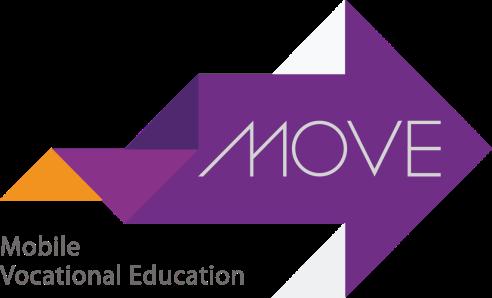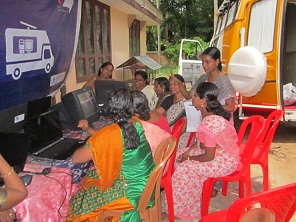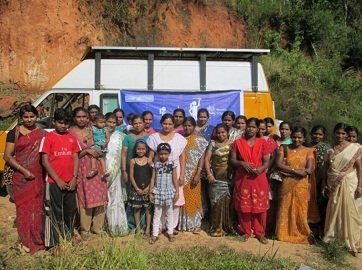MoVE: Carrying Vocational Education and Training beyond Barriers By Akshay Nagarajan
By Akshay Nagarajan, Amrita University, India.
 In India, skills training is the least accessible to those who stand to benefit the most from it. Making vocational education mobile may be one solution to this.
In India, skills training is the least accessible to those who stand to benefit the most from it. Making vocational education mobile may be one solution to this.
Seventy per cent of India’s population resides in rural and tribal areas where lifestyles are intertwined with the land and the seasons. Infrastructure, that urban populations take for granted like reliable electricity, running water, and protective shelter are deemed a luxury by the country’s growing underserved population. Industrial development is encroaching in these areas quickly and is changing the landscape faster than the communities can adapt, adversely impacting lives in multiple ways.
The majority of people in these communities subsist on informal or daily wage work that is notoriously unreliable and riddled with corrupt management practices. The people have no other means of an income, and lack the strength of voice to confront these challenges. For these remote communities to survive and thrive, education, especially vocational skills training, is crucial. However, one of the greatest challenges to providing such an education in rural India is that many people, especially tribal communities, live a great distance from training centres making access impossible. Skills training is the least accessible to those who stand to benefit the most from it. This makes it even more difficult to implement a way to help these communities participate in any formal economic sector, and thereby overcome poverty.
AMMACHI Labs at Amrita University has come up with a solution to this problem with a project called MoVE – Mobile Vocational Education. The project consists of a fleet of fully equipped classrooms on wheels, with laptops/tablets powered by solar panels, to provide technology enhanced vocational education (including multi-modal ICT and haptic simulators) to logistically and geographically diverse areas.
How does it operate?
A MoVE unit carries with it an entire classroom. Storage for laptops, tablets, or other smart devices, large monitors, and course materials is available in the back, along with a desk and small couch. Solar panels power a set of batteries that supply power to the ICT devices and provide lighting for the classroom. When a suitable location is selected, the facilitator simply unpacks the van to set up the virtual classroom that allows students to access the vocational training course of their choice.
 A Vocational Training Centre (VTC), situated at the nearest semi-urban location acts as a hub and co-ordinates the operations and logistics of all the MoVE units. Each MoVE van covers an area that is assigned to it by the VTC. A demand analysis and aptitude assessment for the region is conducted using carefully designed surveys before the VET courses appropriate for that region are selected. Afterwards, the best possible deployment path and schedule for the MoVE unit is mapped. The deployment strategy is influenced by factors such as geography and the available schedule of student beneficiaries. The number of courses offered per location varies from rural areas to tribal regions. The main objective of this program is to deliver high quality Computerized Vocational Education and Training (cVET) & Life Enrichment Education (LEE) to the economically marginalized sections of society who are confined to remote rural areas and tribal regions of the country. MoVE achieves this by delivering education right at their doorstep.
A Vocational Training Centre (VTC), situated at the nearest semi-urban location acts as a hub and co-ordinates the operations and logistics of all the MoVE units. Each MoVE van covers an area that is assigned to it by the VTC. A demand analysis and aptitude assessment for the region is conducted using carefully designed surveys before the VET courses appropriate for that region are selected. Afterwards, the best possible deployment path and schedule for the MoVE unit is mapped. The deployment strategy is influenced by factors such as geography and the available schedule of student beneficiaries. The number of courses offered per location varies from rural areas to tribal regions. The main objective of this program is to deliver high quality Computerized Vocational Education and Training (cVET) & Life Enrichment Education (LEE) to the economically marginalized sections of society who are confined to remote rural areas and tribal regions of the country. MoVE achieves this by delivering education right at their doorstep.
Does it work?
It is a solution that has already proven its worth. MoVE is currently servicing remote communities in support of the Women Empowerment (WE) Project, funded by the United Nations Democracy Fund (UNDEF) and Amrita University, and has been instrumental in raising the number of beneficiaries trained to over 3,000 people. With the help of our partner institution –Amrita Jan Shikshan Sansthan, the MoVE Van has successfully taken vocational education and training on the road, covering 10 villages in Kerala and Tamil Nadu over the past two years.
Our target group for the WE Project consisted primarily of illiterate or semi-literate women living below the poverty line, who have missed out on higher educational opportunities and wish to alter their economic circumstances through vocational training and life skills training. The MoVE project has been operational since September 2012, as part of the WE project.
 Eight of these deployments took place in the rural Idukki district of Kerala that suffers from poor infrastructure, including insufficient electricity, classrooms, storage facilities etc. In just under six months, MoVE was able to train over 600 women from 35 different communities (covering over 10,000 km), in five different vocational trades including: jewellery making, fabric painting, vegetable cultivation, soap making, and flower arrangement. Two other deployments took place in Nagapattinam and Nagore, areas of coastal Tamil Nadu that bore witness to massive damage during the 2004 tsunami that lay waste to parts along the eastern coast line of India. MoVE brought the first opportunity to many villagers in that region who have previously sought vocational education and training.
Eight of these deployments took place in the rural Idukki district of Kerala that suffers from poor infrastructure, including insufficient electricity, classrooms, storage facilities etc. In just under six months, MoVE was able to train over 600 women from 35 different communities (covering over 10,000 km), in five different vocational trades including: jewellery making, fabric painting, vegetable cultivation, soap making, and flower arrangement. Two other deployments took place in Nagapattinam and Nagore, areas of coastal Tamil Nadu that bore witness to massive damage during the 2004 tsunami that lay waste to parts along the eastern coast line of India. MoVE brought the first opportunity to many villagers in that region who have previously sought vocational education and training.
The MoVE schools serve remote communities by teaching them various vocational skills with an aim to make them self-reliant. The computerized coursework and haptic simulators aid in cutting costs on raw materials needed for training and reduce the need for expert trainers who are few and far between in these areas. Additionally, because MoVE contains all of the necessary elements of a classroom, there is a significantly reduced dependence on local infrastructure to hold a VET class. MoVE provides greater geographical reach, reduced operating cost, offering flexible class times and has little dependence on resources.
What is next?
The journey is continuing even today, with deployments planned in as far away as Chhattisgarh and Uttarakandh. The project seeks to mobilize a larger fleet that can operate in the newly identified regions.
 The project faced challenges in its design of a low maintenance, solar powered, easy to setup classroom model, in coordinating participants and scheduling the logistics during the deployment, and in sustaining facilitators over the period of deployment. Addressing these challenges has been a top priority for AMMACHI Labs, and can only be overcome through greater field experience, and in remaining open to adaptation and experimentation in creating new models.
The project faced challenges in its design of a low maintenance, solar powered, easy to setup classroom model, in coordinating participants and scheduling the logistics during the deployment, and in sustaining facilitators over the period of deployment. Addressing these challenges has been a top priority for AMMACHI Labs, and can only be overcome through greater field experience, and in remaining open to adaptation and experimentation in creating new models.
We see the future of MoVE operating under two different models. One being MoVE-in-a-box where we pack the classroom in a box instead of a vehicle and the other, the vehicle housing more heavy duty or emerging vocational tools like 3D printers, laser cutters and welding systems. The second model aims to carry innovation and promote the maker-culture in the villages.
The MoVE has miles to go and millions to reach and hopes to leave a lasting impact on society at large.
Akshay Nagarajan, Team Lead – Mechanical Design and Manufacturing, Ammachi Labs, Amrita University, Kerala, India. Email: akshayn@am.amrita.edu

Pingback : ICTs in Technical and Vocational Skills Development: Reaching the Poorest Populations? | NORRAG NEWSBite
Pingback : NORRAG ICTs in Technical and Vocational Skills Development: Reaching the Poorest Populations? - NORRAG